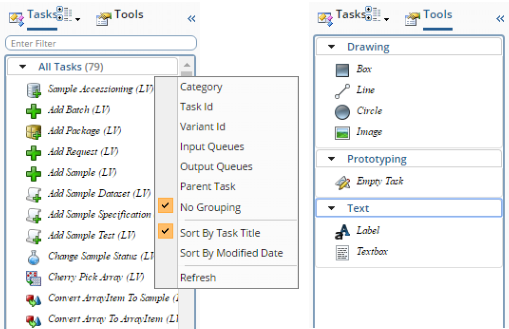Content |
||||||||||||||||||||||||||
|
Overview |
|
|
Launched from Workflow Definition List page, the Workflow Definition Maintenance Page lets you configure and maintain Workflow Definitions.
Workflow Details |
|
|
"Workflow Details" defines identification and execution information for the Workflow Definition.
Workflow Details Form |

|
| Field/Option | Description | |
| Workflow Id | Identifier of the Workflow SDI. | |
| Version | Version number of the Workflow SDI. | |
| Variant | Variant of the Workflow SDI. | |
| Description | Text description that is displayed on the Workflow Definition List page. | |
| Execution Type | Specifies the Workflow Execution Type. | |
| Line style | Determines the style of the connecting line
between Tasks:
|
Toolbar Buttons |
The "File" button collection lets you perform these operations:
| Button | Description |
| Save | Saves changes made to the Workflow Definition. |
| Add Another | If there are no unsaved changes to this Workflow Definition, this opens a new Workflow Definition Maintenance page in which you can define a new Workflow Definition. |
| Return | If there are no unsaved changes to this Workflow Definition, this returns you to the Workflow Definition List page. |
The "BPMN" button collection lets you perform import and export operations (see Importing and Exporting).
Workflow Tasks |
|
|
Overview |
"Workflow Tasks" is where you actually build and configure a Workflow Definition.
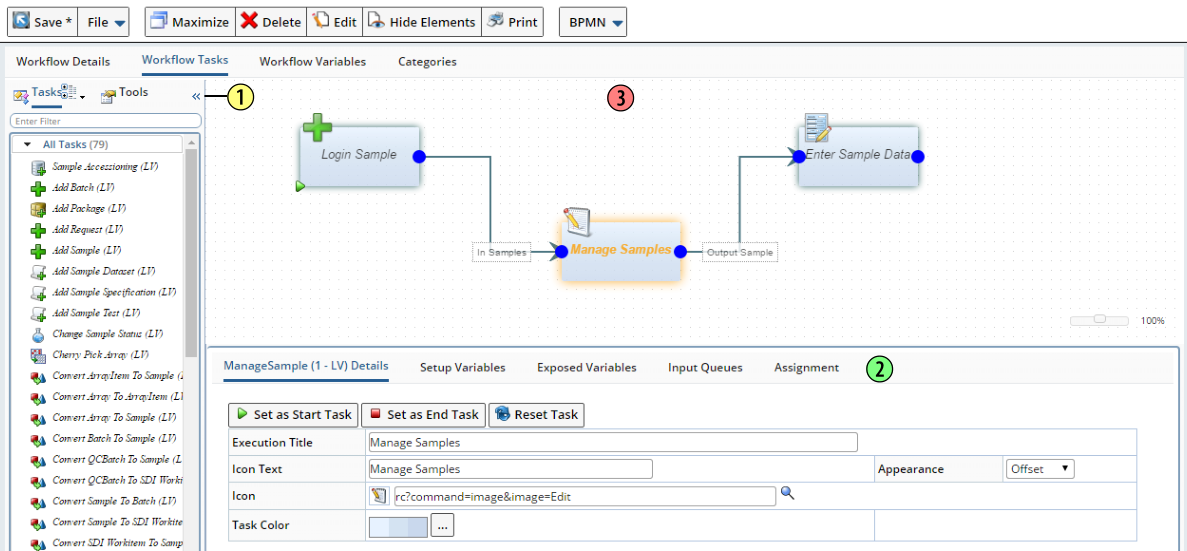
|
| 1. | Tasks and Tools Panel |
| 2. | Task Details |
| 3. | Workflow Design Area |
Toolbar Button Operations |
In addition to the File and BPMN toolbar buttons, the "Actions" button collection lets you perform these operations:
| Button | Description |
| Maximize/Restore | "Maximize" enlarges the page to fill the frame by hiding the Sidebar and Layout header. "Restore" reduces the page to include the Sidebar and Layout header. |
| Delete | Deletes the selected Task from the Workflow Design Area. |
| Edit | For the selected Task, opens the Workflow Task Definition page where you can edit the Task. A "Close" button is provided when you have finished editing. |
| Show Elements/Hide Elements | Shows/hides graphical elements you have added using the drawing and prototyping tools in the Tools Panel. |
| Opens a print dialog from where you can print the Workflow Design graphic. |
Tasks and Tools Panel |
The "Tasks" panel (below left) provides Tasks that you can drag-and-drop into the Workflow Design Area as shown in Introduction to Workflows. You can also group the Tasks using the options shown below. The "Tools" panel (below right) provides the drawing and prototyping tools shown below.
|
You can change the grouping of Tasks by right-clicking the Task Bar and categorizing them as desired:
|
Workflow Task Details |
|
|
"Task Details" provides operations that affect the Task selected in the Workflow Design Area.
Task Details |
The "Task Detail" identifies the selected Task in the tab label by its primary keys.

|
| Button | Description |
| Set as Start Task | Makes the selected Task the Start Task for the Workflow. "Set as End Task" is then disabled for the selected Task. |
| Set as End Task | Makes the selected Task the End Task for the Workflow. The button then changes to "Unset as End Task", which will reverse the operation when clicked. |
| Reset Task | If you have overridden properties that were specified by the Task Definition, this issues a confirmation message. If you confirm, this resets all of the overridden properties back to original Task Definition properties. |
| Field/Operation | Description |
| Execution title | Text that is displayed in the page header when the Task executes (see Displaying Information). |
| Icon Text
Appearance Icon Task Color |
Appearance settings specified by the Task Definition. |
Setup Variables |
"Setup Variables" provides control over Setup Variables defined for the Task (see Task Variables for an example).

|
Exposed Variables |
Task Variable that is configured as "Exposed to Workflow" such that the value of this Variable in this Task can be accessed elsewhere in the Workflow. This lets you declare a Workflow Variable to which a Task Variable can be set. When the Task completes, it can then update the centralized Workflow Variable with the value of the Task Variable. This lets you use the value downstream in the Workflow.

|
Input Queues |
This shows Input Queues for the selected Task. "Workflow Input" applies to when you are using the AddToWorkflow Action. When you add SDIs to a Task that has a single Input Queue for a given SDI, it is unambiguous to the Action as to which SDIs are going into which Queue. However, if the Task has two Input Queues that each accept the same SDC, you can specify an arbitrary "Workflow Input Name" here, and specify it using the Action properties.

|
Assignment |
As Tasks can have Assignments, they can be defined at the Workflow level as well. Here, "Assignment" also lets you specify the default assignment for SDIs going into the Input Queue of this Task when you first populate the Input Queue with the SDIs.

|
In addition to "User", "Department", and "Role", this also offers:
| Assignment | Default Assignment for Input SDIs |
| Inherit | Inherits assignment from the prior Task. |
| All | No restrictions. |
| Current User | The current User. |
| Current Department | All Users in the current Department. |
Workflow Variables |
|
|
See Workflow Variables for an example.
Categories |
|
|
"Categories" lets you specify Categories to which the Workflow Definition belongs.
Importing and Exporting |
|
|
The "BPMN" button collection lets you perform these import and export operations:
| Button | Description |
| Import | Imports a prototype XPDL (XML Process Definition Language) or BPMN (Business Process Model and Notation) format as a Workflow Definition with prototype Tasks, which can then be substituted with actual Tasks or used to create new Tasks. |
| Export BPMN | Exports the current Workflow Definition to BPMN format. |
| Export XPDL | Exports the current Workflow Definition to XPDL format. |
The "Export" buttons simply export the current Workflow Definition in the chosen format. Importing requires a demonstration. The following example imports an XPDL file.
We begin the import by adding a new Workflow Definition, then opening it to the "Workflow Tasks" detail to reveal the blank Workflow Design Area. Click "Import".
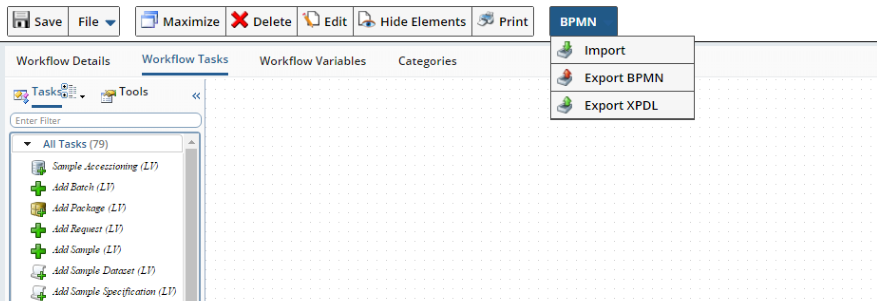
|
In the Import dialog, click the text and select your file as shown below (note that you can also drag the file into the Import dialog), then click "Import".
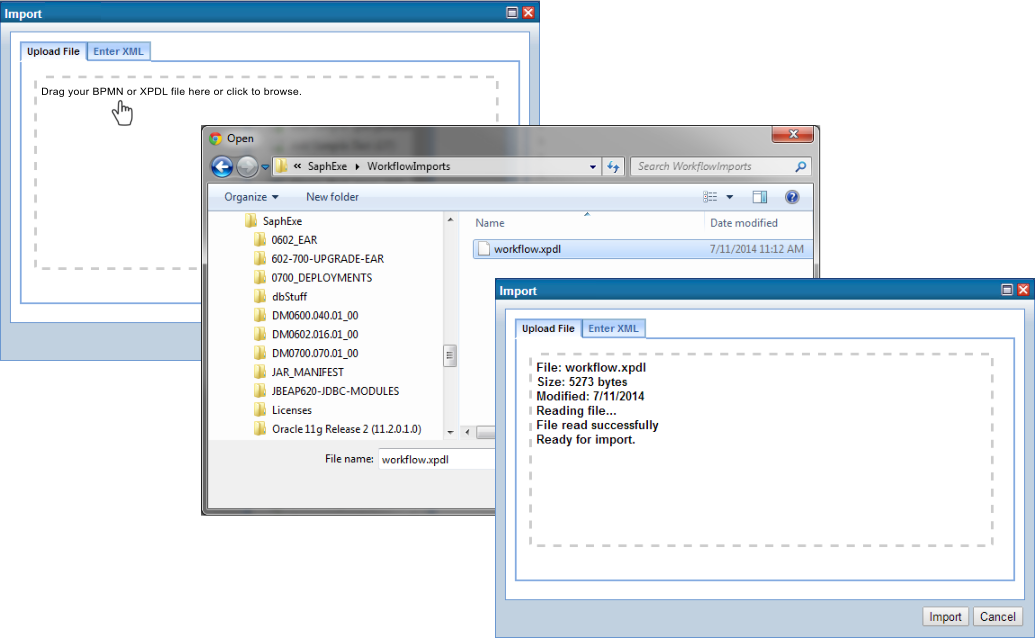
|
The prototype is then imported as shown below.
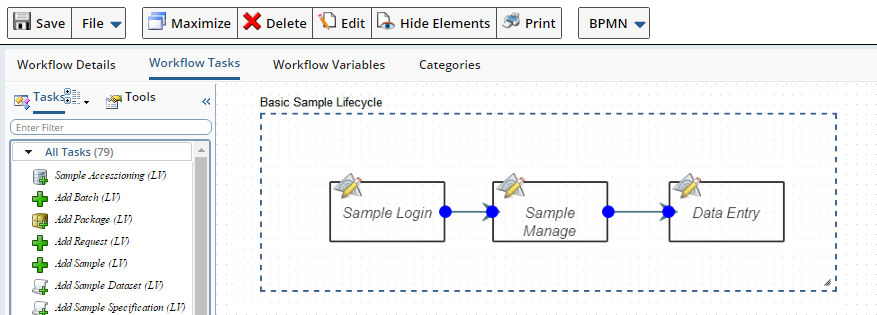
|
To replace a prototype Task with an actual Task, right-click the Task, then select "Swap with Task". Choose the actual Task from the lookup, and the prototype is replaced with the actual Task.

|

